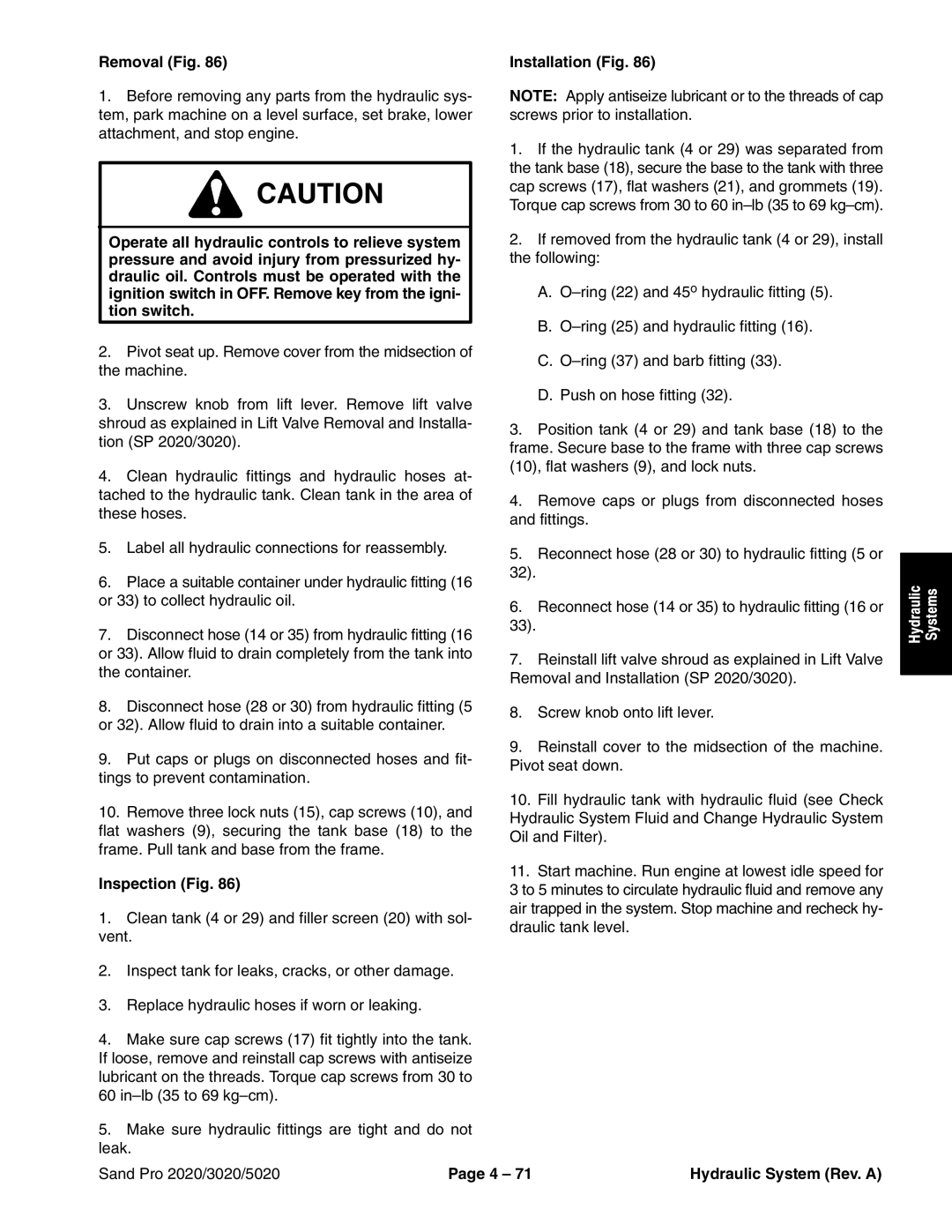
Removal (Fig. 86)
1.Before removing any parts from the hydraulic sys- tem, park machine on a level surface, set brake, lower attachment, and stop engine.
![]() CAUTION
CAUTION
Operate all hydraulic controls to relieve system pressure and avoid injury from pressurized hy- draulic oil. Controls must be operated with the ignition switch in OFF. Remove key from the igni- tion switch.
2.Pivot seat up. Remove cover from the midsection of the machine.
3.Unscrew knob from lift lever. Remove lift valve shroud as explained in Lift Valve Removal and Installa- tion (SP 2020/3020).
4.Clean hydraulic fittings and hydraulic hoses at- tached to the hydraulic tank. Clean tank in the area of these hoses.
5.Label all hydraulic connections for reassembly.
6.Place a suitable container under hydraulic fitting (16 or 33) to collect hydraulic oil.
7.Disconnect hose (14 or 35) from hydraulic fitting (16 or 33). Allow fluid to drain completely from the tank into the container.
8.Disconnect hose (28 or 30) from hydraulic fitting (5 or 32). Allow fluid to drain into a suitable container.
9.Put caps or plugs on disconnected hoses and fit- tings to prevent contamination.
10.Remove three lock nuts (15), cap screws (10), and flat washers (9), securing the tank base (18) to the frame. Pull tank and base from the frame.
Inspection (Fig. 86)
1.Clean tank (4 or 29) and filler screen (20) with sol- vent.
2.Inspect tank for leaks, cracks, or other damage.
3.Replace hydraulic hoses if worn or leaking.
4.Make sure cap screws (17) fit tightly into the tank. If loose, remove and reinstall cap screws with antiseize lubricant on the threads. Torque cap screws from 30 to
60
5.Make sure hydraulic fittings are tight and do not leak.
Installation (Fig. 86)
NOTE: Apply antiseize lubricant or to the threads of cap screws prior to installation.
1.If the hydraulic tank (4 or 29) was separated from the tank base (18), secure the base to the tank with three cap screws (17), flat washers (21), and grommets (19). Torque cap screws from 30 to 60
2.If removed from the hydraulic tank (4 or 29), install the following:
A.
B.
C.
D.Push on hose fitting (32).
3.Position tank (4 or 29) and tank base (18) to the frame. Secure base to the frame with three cap screws (10), flat washers (9), and lock nuts.
4.Remove caps or plugs from disconnected hoses and fittings.
5.Reconnect hose (28 or 30) to hydraulic fitting (5 or
32).
6.Reconnect hose (14 or 35) to hydraulic fitting (16 or
33).
7.Reinstall lift valve shroud as explained in Lift Valve Removal and Installation (SP 2020/3020).
8.Screw knob onto lift lever.
9.Reinstall cover to the midsection of the machine. Pivot seat down.
10.Fill hydraulic tank with hydraulic fluid (see Check Hydraulic System Fluid and Change Hydraulic System Oil and Filter).
11.Start machine. Run engine at lowest idle speed for 3 to 5 minutes to circulate hydraulic fluid and remove any air trapped in the system. Stop machine and recheck hy- draulic tank level.
Hydraulic | Systems |
|
|
Sand Pro 2020/3020/5020 | Page 4 – 71 | Hydraulic System (Rev. A) |
